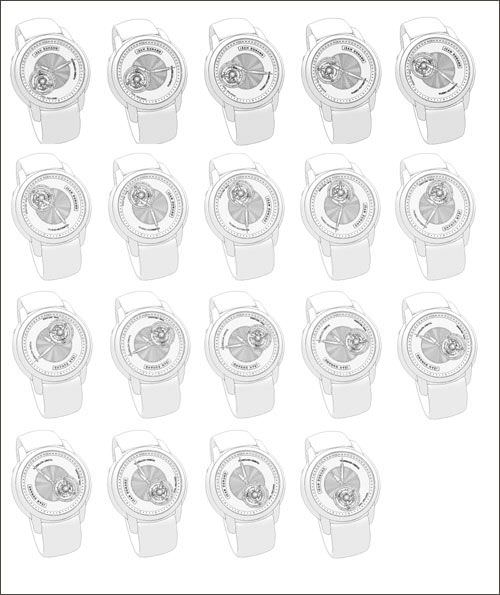
The day that I received a telephone call requesting a meeting “regarding an entirely new brand in the haut de gamme sector,” I could not help but feel a little sceptical. Oh, another one, I thought to myself. Hadn’t the mad rush upmarket by Swiss watchmakers during the last few years finally come to an endı Weren’t there enough brands juggling for space at the top of the pyramidı Hadn’t the recent craze for diamond-set watches, followed by the tourbillon folly of this year, left enough ‘victims’ in their wakeı
So, it was in this state of mind, that I agreed to meet with Thierry Oulevay. The man was already familiar to me as one of the founders of the brand Bovet and I appreciated the high quality of work he had done while there, but, after he left Bovet, I had no news of him. He came to my office at the scheduled time and, during our long conversation, detailed his projects and showed me a few examples of his new watches. After he left, I had to admit that my doubts about this new brand were swept away. Now I am sure that the launch of Jean Dunand will be immediately admired for its unprecedented qualities.
Beginning with the dream…
Like in many inspiring stories, everything begins with a dream. In this case, the dreamer is not just anybody, but Christophe Claret. A relatively quiet and unassuming man standing in contrast to the cacophony of egos present in the realm of Haute Horlogerie, Claret is the driving force behind a number of major innovations in prestige Swiss timekeeping. With his team of 60 watchmakers and technicians, he provides timepieces for numerous clients that are amongst the most renowned in the industry.
The creation, production and finishing of different movements such as Westminster minute repeaters, tourbillons, tourbillon minute repeaters with flyback chronographs or musical watches, hold no secrets for him. To his talent can be added a grain of folly, a combination that often makes the difference in this creative domain. An example is the recent Opus IV, made for Harry Winston, which combines a tourbillon and minute repeater on one face, and a large lunar phase indicator with date on the other, the two faces with hours and minutes (hand-fitting on each face of the watch which is articulated, perfectly symmetrical and designed to be worn showing either face). Dress it all up with dazzling diamonds and you know it was not created by just anybody.
Getting back to his dream… this night, Christophe Claret tosses and turns, having a really wild dream – to design and build a 60-second flying tourbillon whose cage itself makes a complete rotation around the centre of the watch in one hour. Whoever would conceive a crazy idea like that!!
How to make the barrel turn around the centre of a movementı
As the sun begins to rise, Claret takes a pencil in hand and starts drawing his dream. He certainly has his work cut out. To make the tourbillon’s cage rotate, the barrel must necessarily rotate as well, since this is the energy source. So, how can the barrel transmit its energy in a constant manner while rotating around a fixed centre on a plateı
After a few hours of deep thought, the solution jumps out at him. The tourbillon and the barrel can be sandwiched together in a large cage that rotates around the centre. But doesn’t this large cage (not to be confused with the small cage of the tourbillon) have to be able to rotate in both directions, clockwise and anticlockwise, one way for the tourbillon’s orbital rotation and the opposite way to wind it and set the timeı The solutionı A single ball bearing with two separate directional rotations.
The ball bearing makes up the central axis of the movement. It is connected to the base plate, which remains fixed to the back of the case and allows the upper plate of the sandwich to turn in both directions. Simpleı Yes, on paper. However, in reality, there are a number of non-trivial problems.
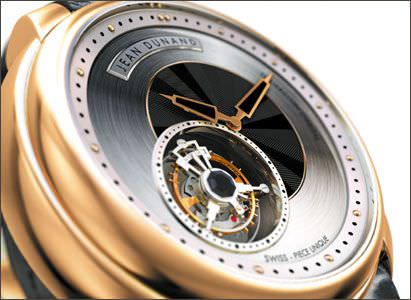
3/4 view of the watch highlighting the central part of the dial in 18 carat gold with ‘sapin’ (pine) guilloche and the satin-finished circular exterior. The flange is fixed to the case, thus the movement/dial turns once every hour taking with it the flying tourbillion.
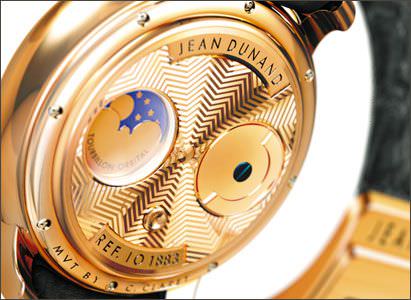
View of the caseback with its ‘sapin’ guilloche, the moon phases with its rapid corrector and the winding crown which is integrated into the caseback.
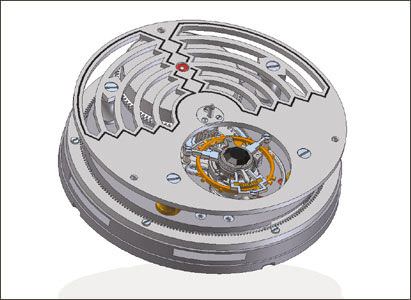
The patented Io 200 Christophe Claret movement made exclusively for Jean Dunand with a view of the tourbillon and the going barrel. Note the cutting away of the upper plate and the art-deco-inspired ‘Palm tree’ decoration.
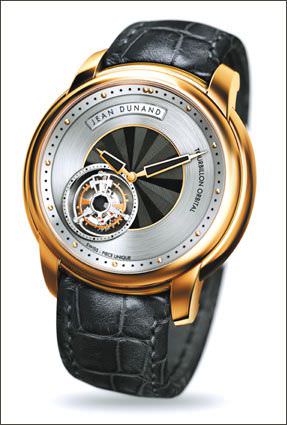
An exceptional movement for a prestige timepiece, perfectlty symetric due to the absence of a crown at 9 o’clock.
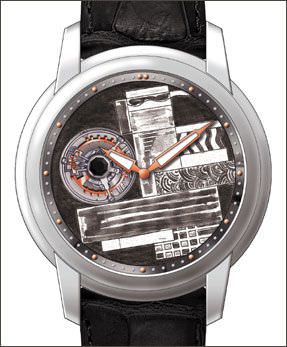
A veritable ‘moving tableau’: an art-deco dial resulting from research into the various aspects of graphic design, colour and materials.
The problems
The first problem is how to transmit the driving force of the barrel to the tourbillon, as the barrel itself rotates.
To solve this problem, Christophe Claret comes up with the idea of a centre wheel fixed to the case, with internal toothing that transmits the ‘information’ from the barrel to the tourbillon cage, which itself acts as a regulator (because the tourbillon makes a revolution in one minute). In doing so, Christophe Claret discovers an unexpected advantage.
Since the energy is transmitted by the ball bearing, there is no need for a traditional gear train between the barrel and the cage. The result is a better performance due to the extreme precision of the ball bearing since there is no rubbing of the centre wheel’s axis. Besides the better performance, there are other advantages: great amplitude stability because there are no variations due to different positions; improvement in the watch’s operation by the creation of a double tourbillon effect. “The basic idea was to make something a little bit crazy,” explains Christophe Claret, “but, the improvement in terms of precision is a wonderful and surprising plus!”
Another problem, and not the least, which is also inherent in the system, is how to transmit the winding energy to the barrel. It is obvious that a normal winding stem, thus one that is fixed, is totally incompatible with an upper plate that turns! So, how can Claret resolve this major problemı
We cannot give away the entire solution of the problem. And yet, at the risk of frustrating you and in agreement with the ingenious creator, we keep the secret of this fabulous patented movement intact … but having seen it with my own eyes, I can assure you that it works!
Prestige poetry
The name of the movement is Io 200, where ‘Io’ refers to a moon of Jupiter discovered by Galileo in 1610, whose size is nearly the same as a planet, while the ‘200’ is short for 2000, the year that the system was designed. Besides its eminently technical appearance and its intrinsic beauty (which comes from its apparent simplicity and its elegant construction), the Io 200 is a piece of prestige poetry. And it’s here that Thierry Oulevay returns to the story.
After having solidified his ‘dream’ in the form of actual plans, Christophe Claret proposed it to various leading brands for whom he creates. “Too crazy,” “too extravagant,” “it will never work” were the responses he got. Discouraged, he put his wonderful dream in a drawer. Then one day, Thierry Oulevay called him.
The two men were immediately on the same wavelength. With his vast experience in the haut de gamme watch sector, and his passion for Art Déco, Oulevay wanted to create a niche watch brand, a brand that would create exceptional and even unique products that would draw inspiration from the styles of the 1920s and 1930s to make contemporary timepieces. Sharing his passion and ideas, Christophe Claret straight away accepted to become his partner in the venture.
Who is Jean Dunandı
So, the brand Jean Dunand was born, under the label of the new enterprise WPW SA (for World Première Watchmaking). Its first model would be the Tourbillon Orbital.
Why the name Jean Dunandı This creator of Swiss origin (1877 – 1942) was one of the leading representatives of the Art Déco era. Pioneer in brassware and lacquer from 1909, Dunand designed and produced numerous vases, furniture and various decorative panels and other items. Also notably, he contributed to the décor of the large cruise ships, such as the Ile de France (1928), the Atlantique (1931) and the famous Normandie (1935). He also created jewellery and accessories.
Taking a name from outside the watch sector seemed appropriate for a brand that wanted to be both innovative in the domain of the complicated timekeeper and creative in drawing on an intensively creative past for its decorative contemporary ideas. In this way, it’s also a homage to a man and his work which Thierry Oulevay and Christophe Claret pledge enormous respect and admiration.
The Tourbillon Orbital seems to be the ideal canvas for this type of ornamental research since it offers, by the rotation of its dial, a real moving tableau. Each watch will be truly unique. The two men are exploring new materials, such as dials made of ornamental stones, fossilized caviar and anaconda. Their forays into art and form take them into lacquering, enamelling, engraving, and geometric shapes and chromatic combinations.
“Each piece must be considered as a work of art,” explains Thierry Oulevay, “whether we are talking about its exterior appearance, its movement, or the extremely rigorous and strictly personalized attention we bring to the finishing.”
Only the beginning
The Tourbillon Orbital is the first step. Each new movement that the Jean Dunand brand introduces will have a world’s first in terms of technique. This might mean a completely new calibre or an additional complication in the same character. The two partners have announced that for 2005, they will present a Cathedral Minute Repeater in a form case equipped with a complication that they qualify as “absolutely unique in its category and totally new, even revolutionary.”
Given the high art of this Haute Horlogerie, what do these ‘unique pieces’ costı Well, as you might guess, Jean Dunand timepieces are not for everyone. Entry-level prices start around 250,000 euros and above to acquire one of these ‘masterpieces’, entirely manufactured in the Claret workshops, the first of which are now seeing the light of day. If, at first glance, the price might seem rather exorbitant for a new brand, it nevertheless is justified in light of the research that has gone into the movement, its rich decoration and its totally original appearance. As a single example, the development of the microscopic and ultra-technological axis and ball bearing system has been so expensive that each piece costs several thousand euros.
Given the encouraging response, and knowing that the first models have already been reserved, the two men are confident in their new adventure and estimate they can produce about one hundred watches over the next two years. We can also suppose that Jean Dunand will make a striking entrance into the high orbit of Haute Horlogerie.
WPW (World Première Watchmaking) SA
31, chemin Pré-Fleuri
1228 Plan-les-Ouates
Suisse
Tel. : +41 22 706 19 60
Fax : +41 22 706 19 69
e-mail : [email protected]





